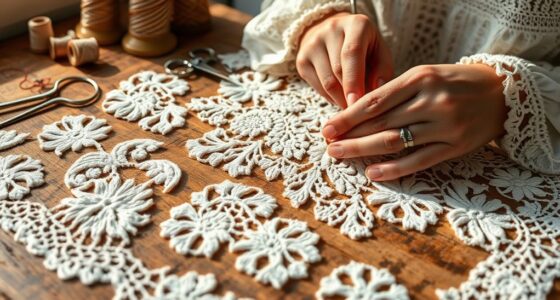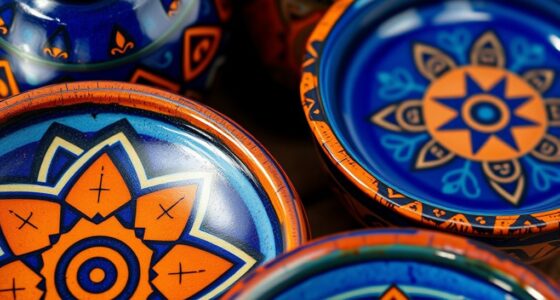In Sardinia, you’ll find a centuries-old cork industry that combines sustainable harvesting with traditional craftsmanship. Cork oak trees are carefully tapped every 9–12 years to produce high-quality cork used mainly for wine stoppers. Skilled artisans craft unique jewelry, art, and functional items by hand, combining age-old techniques with modern innovations. This ecosystem-friendly practice supports local economies and cultural heritage. If you keep exploring, you’ll discover how this sustainable industry continues to thrive today.
Key Takeaways
- Sardinia produces 70% of Italy’s cork, mainly for wine stoppers, supporting local industry and employment.
- Cork harvesting is sustainable, involving manual techniques that preserve cork oak trees over multiple decades.
- Traditional crafting techniques emphasize hand shaping, smoothing, and layering, often combined with textiles and artistic embellishments.
- The industry integrates ecological practices, ensuring forest health, biodiversity, and cultural heritage preservation.
- Sardinian cork craftsmanship blends tradition with innovation, promoting eco-friendly art, jewelry, and functional objects.
Sardinia’s Cork Production Landscape
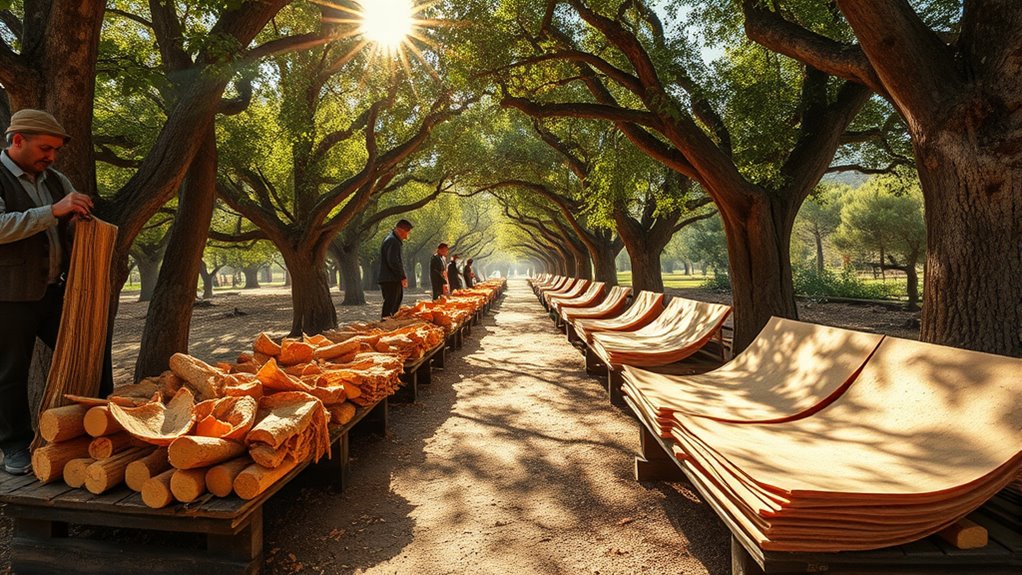
Sardinia’s cork production landscape is a vital part of the island’s economy and cultural heritage. Each year, you contribute to the production of about 17,000 to 20,000 tonnes of cork, making Sardinia responsible for roughly 70% of Italy’s total cork output. The industry supports around 25 industrial firms and 30 artisanal workshops, providing jobs for approximately 850 people and generating over 20 million euros annually. Known for its high-quality cork, Sardinian cork mainly serves the wine bottle stopper market, with 60-70% of the cork used for this purpose. The industry seamlessly blends traditional craftsmanship with commercial production, maintaining its importance in local communities. Cork harvesting occurs every 9 to 12 years, ensuring sustainability and preserving Sardinia’s cultural identity. Cork oak forests are carefully managed to balance economic benefits with ecological conservation, with sustainable harvesting practices playing a crucial role in preserving these ecosystems.
Key Regions and Land Use Patterns
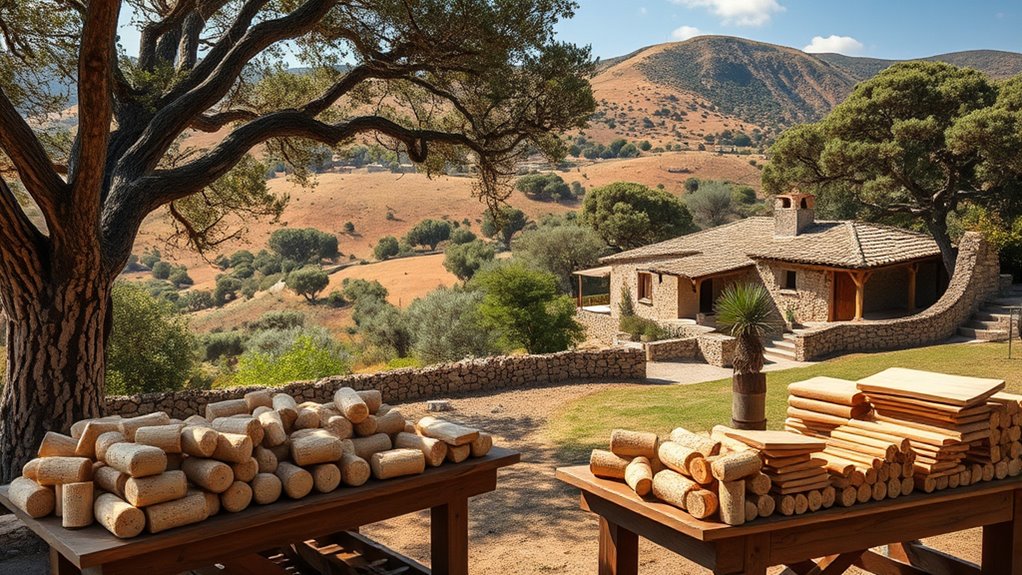
Where are the key areas for cork oak forests in Sardinia? The main regions are in northern and central Sardinia, especially around Calangianus and Tempio. These areas sit at 500-900 meters altitude in eastern Sardinian mountains, where granite soils and a moderate climate create ideal conditions for cork oaks. Covering about 90,000 hectares—roughly 4% of the island’s land—these forests are part of Sardinia’s extensive natural landscape, which exceeds 1.2 million hectares. Cork oak forests in Sardinia are managed through a combination of traditional practices and modern forestry techniques. Land use patterns often combine cork oak stands with grazing, agriculture, and forest management. Public and private ownership leads to varied practices, including grazing restrictions in pure cork oak stands to preserve cork quality. Mechanical clearing and multifunctional land use help sustain the ecosystem and cork industry’s economic relevance.
The Cork Harvesting Cycle and Techniques
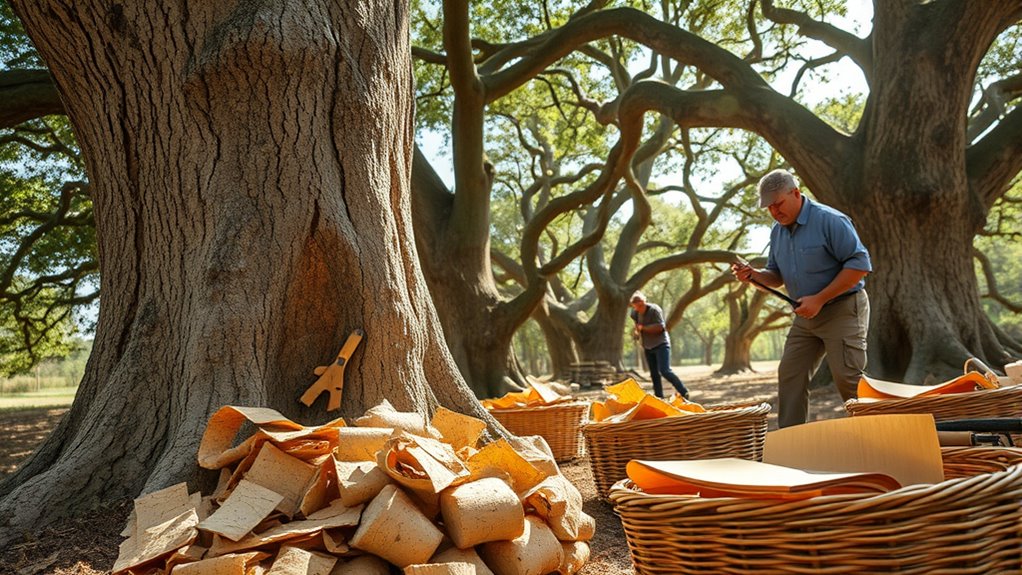
Cork harvesting follows a carefully scheduled cycle that guarantees both tree health and high-quality production. You’ll harvest only during summer, when the bark separates easily, avoiding damage to the cambium. Each tree can be tapped up to 12 times over 150–250 years, with intervals of 9–12 years between harvests. Skilled harvesters use a specialized axe to peel large cork strips by hand, ensuring minimal stress to the tree and preserving future yields. The process involves alternating around the trunk to expand the harvested sections. After collection, cork planks are sorted, cured for at least 8 months, and then cut into strips within 24 hours to prevent mold. Efficient and careful techniques maintain both quality and sustainability.
| Stage | Timing | Tools & Technique |
|---|---|---|
| Bark Preparation | Summer, every 9–12 years | Hand-held axe, manual peeling |
| Sorting & Curing | Post-harvest, 8+ months | Air circulation, stabilization |
| Production & Cutting | Within 24 hours after curing | Manual, precise cutting |
Silvicultural Practices and Forest Management
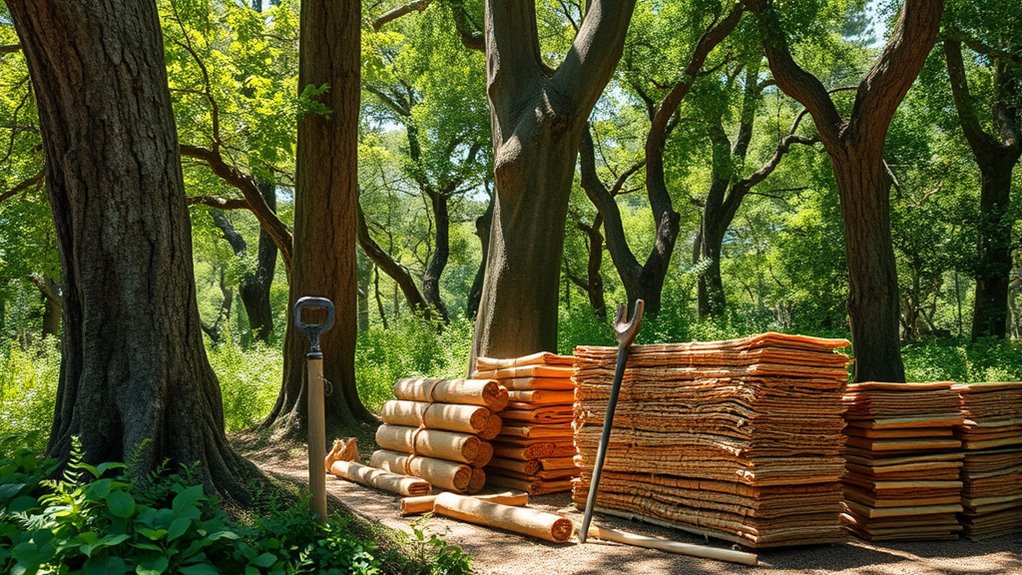
You need to understand how cork harvesting cycles influence forest management decisions, balancing yield with tree health. Thinning techniques are essential for optimizing cork quality while maintaining ecosystem balance, and grazing strategies can affect forest structure and regeneration. By considering these practices together, you can develop sustainable silvicultural approaches that support both cork production and ecosystem integrity. Cork oak stands are multi-aged, which affects how management strategies should be tailored to ensure long-term sustainability. Additionally, implementing proper fire safety measures is crucial to protect these forests from potential fire hazards associated with land management activities.
Cork Harvesting Cycles
The cork harvesting cycle in Sardinia typically spans around 11 years, guaranteeing that bark regeneration occurs without harming the trees. You’ll find that trees must reach at least 25 years old before their first harvest, allowing for adequate growth. Subsequent harvests happen every 9 to 12 years, usually averaging 11 years, to protect the health of the trees. During harvesting, bark is carefully stripped without damaging the cambium, maintaining continuous growth. This sustainable cycle supports multiple benefits:
- Promotes bark regeneration for future harvests
- Balances economic yield with tree health
- Allows ecological functions like carbon sequestration
- Ensures long-term forest sustainability and ecosystem health
- Research indicates that this cycle also helps preserve the cultural heritage associated with cork oak forests, strengthening regional identity and traditional practices. Additionally, implementing forest management practices that respect natural cycles enhances the resilience of cork oak ecosystems against climate change and pests.
Forest Thinning Techniques
Effective forest thinning in Sardinian cork oak landscapes involves carefully removing selected trees to optimize stand structure and resource distribution. You focus on removing suppressed or poorly formed trees, prioritizing healthy, vigorous oaks, especially during early to mid-rotation phases aligned with cork harvesting cycles. Thinning improves light penetration and resource availability, boosting cork quality and reducing disease risks. Mechanical removal of understory vegetation complements thinning efforts, lowering competition and fire hazards. The intensity and timing depend on forest age, site productivity, and management goals, whether conservation or production. You also monitor ecological outcomes through periodic inventories, adjusting practices as needed. Proper thinning maintains stand heterogeneity, supporting biodiversity, resilience, and multifunctional land use, balancing cork production with ecosystem services like fodder, carbon sequestration, and water yield. Additionally, vetted cork product reviews can guide sustainable harvesting practices and ensure high-quality outputs.
Grazing Management Strategies
Grazing management strategies play a crucial role in maintaining the multifunctionality of Sardinian cork oak forests. Proper regulations help prevent overgrazing and soil degradation while balancing livestock needs and forest regeneration. By managing grazing intensity, you ensure fodder availability without damaging cork trees or understorey vegetation. Rotational grazing and controlled livestock densities protect young cork oaks vital for cork harvesting cycles. These practices are implemented by both public and private managers, aligning with sustainable forest policies and certification standards like FSC and PEFC. Implementing electric power generation techniques can also help monitor and optimize grazing patterns to further support sustainable management.
The Art of Crafting Cork Products
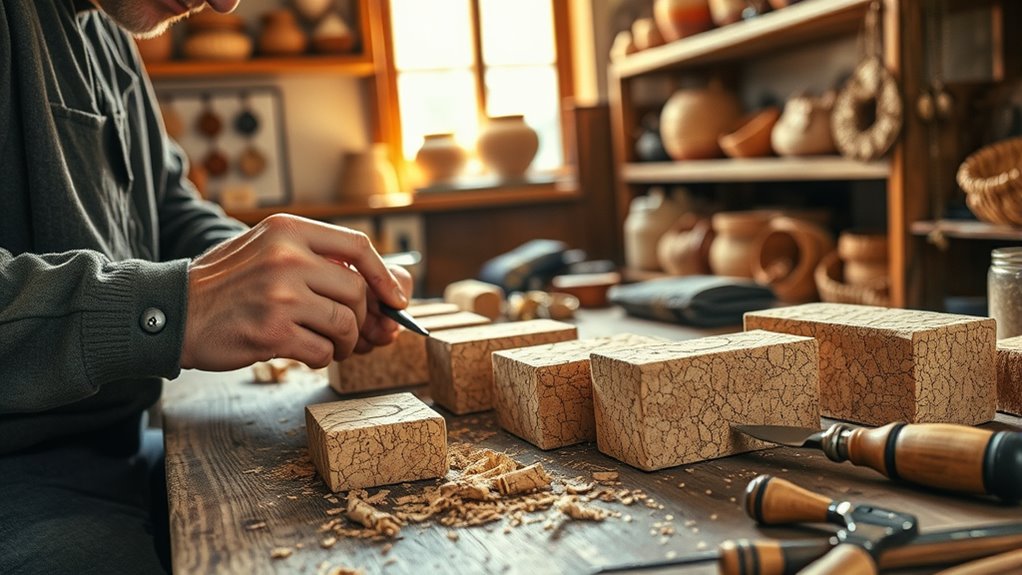
You can see how traditional techniques form the foundation of Sardinian cork craftsmanship, emphasizing handcrafted quality and unique designs. Modern innovations, however, push the boundaries, allowing artisans to create more diverse and functional products. Cork artisans participate in harvesting, boiling, burning, and creating products, ensuring the preservation of regional heritage. These processes require a high level of skill and knowledge of diverse cork processing methods, which are passed down through generations. Together, these approaches keep the art of cork crafting vibrant and relevant today.
Traditional Craft Techniques
Traditional cork crafting in Sardinia relies on time-honored techniques that emphasize manual skill and minimal mechanization. You work with boiled cork planks, shaping and smoothing them with basic tools like knives, hammers, files, and saws. Artisans often repurpose the rougher male cork (*sugherone*) for insulation, reserving finer cork for detailed products. You shape cork into items such as bottle stoppers, household goods, and roofing materials using hand-cutting and pressing methods. Finishing touches involve coating and burning techniques that add color, texture, and durability. Knowledge is passed down through generations, preserving Sardinian craftsmanship. Cork is naturally elastic and compressible, allowing artisans to create complex shapes and detailed designs. Hand tools for cutting, shaping, and smoothing are essential in maintaining the traditional quality of Sardinian cork products. Traditional techniques also include manual layering and pressing techniques that ensure durability and uniqueness in each piece. Combining cork with traditional materials like textiles or wood can enhance the aesthetic and functional qualities of the finished product. Finishing with coating and burning methods not only adds visual appeal but also helps protect the cork from environmental damage.
Modern Artistic Innovations
Modern artistic innovations in Sardinian cork craftsmanship are transforming the material from purely functional to highly expressive art forms. You see artisans blending cork with metalwork, using traditional wrought iron, copper, and tin techniques to craft ornamental sculptures, furniture, and architectural details. Cork is also integrated into mixed-media artworks, often combined with embroidery and textile motifs inspired by Sardinian costumes, like Laura Puggioni’s Sinzos line. Modern crafts de-contextualize cork objects, turning everyday items into jewelry, decorative panels, and furniture elements that push creative boundaries while honoring tradition. The lightweight, malleable qualities of cork enable you to explore new forms and artistic expressions. This approach emphasizes aesthetic experimentation, moving beyond utility to celebrate cork’s artistic potential—an innovative fusion of cultural heritage and contemporary design. Cork’s versatility as a material allows artisans to reimagine its role in modern art and craft, especially considering its sustainable and eco-friendly qualities.
Industrial Processing and Innovative Uses
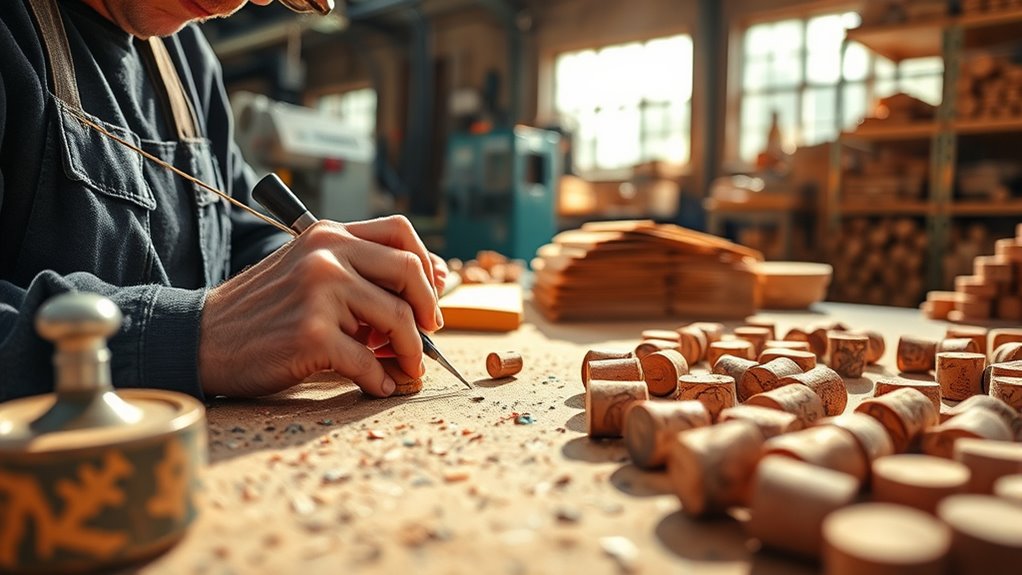
Industrial processing techniques in Sardinia’s cork industry focus on maximizing yield and quality through carefully timed harvesting and advanced post-harvest treatments. You’ll see methods like seasoning the bark in vats for up to two years to stabilize the cork, followed by boiling to flatten and soften it for shaping. About 60% of cork goes into manufacturing roughly 15 billion stoppers annually. Modern innovations include mechanical debarking, which boosts efficiency but raises safety concerns. Here are some key points:
- Rigorous quality control with lab analysis guarantees consistent standards.
- Sardinia holds 83% of Italy’s cork oak forests, with sustainable harvesting protocols.
- Cork is repurposed into insulation, textiles, and household items.
- Artisans craft waterproof, biodegradable cork fabrics for fashion and design.
- The industry employs advanced machinery to improve processing speed while maintaining high quality standards. Additionally, the industry emphasizes sustainable harvesting practices to ensure the longevity of cork oak forests and support ecological balance.
Cultural Heritage and Traditional Crafts

The rich history of cork production in Sardinia is woven into the island’s cultural fabric, with practices that have endured for over three millennia. You can see this in how cork crafting remains a essential part of local life, especially in Calangianus and Tempio Pausania. Artisans continue to use traditional techniques, hand-carving and shaping cork into household objects, jewelry, and decorative items. These crafts are more than functional—they embody Sardinian identity and resourcefulness. Museums like the Museum of Cork in Calangianus preserve this heritage, educating visitors about ancient methods and local history. Cork harvesting, done sustainably from mature cork oaks, reflects a deep respect for nature and tradition. This craftsmanship connects generations, reinforcing a sense of pride and cultural continuity across Sardinia. Cork craftsmanship remains a vital expression of Sardinian cultural heritage, ensuring that traditional skills are passed down and celebrated.
Ecosystem Services and Economic Impact

Cork oak forests in Sardinia play a vital role beyond their economic value, providing essential ecosystem services that benefit both the environment and local communities. These forests help sequester carbon, support biodiversity, and maintain soil stability, reducing erosion and protecting agricultural land. They also supply resources like grazing and firewood, blending ecological and economic functions. The economic impact extends through employment in over 25 enterprises and 30 handicraft firms, generating more than 20 million euros annually. Additionally, cork forests enhance scenic landscapes, attracting rural tourism and supporting local livelihoods. Implementing risk management techniques can further safeguard these valuable ecosystems against environmental and economic challenges.
- Sequester carbon and regulate climate
- Provide habitat for Mediterranean species
- Support soil stability and reduce erosion
- Boost rural tourism and local economies
Preserving Sustainability and Heritage
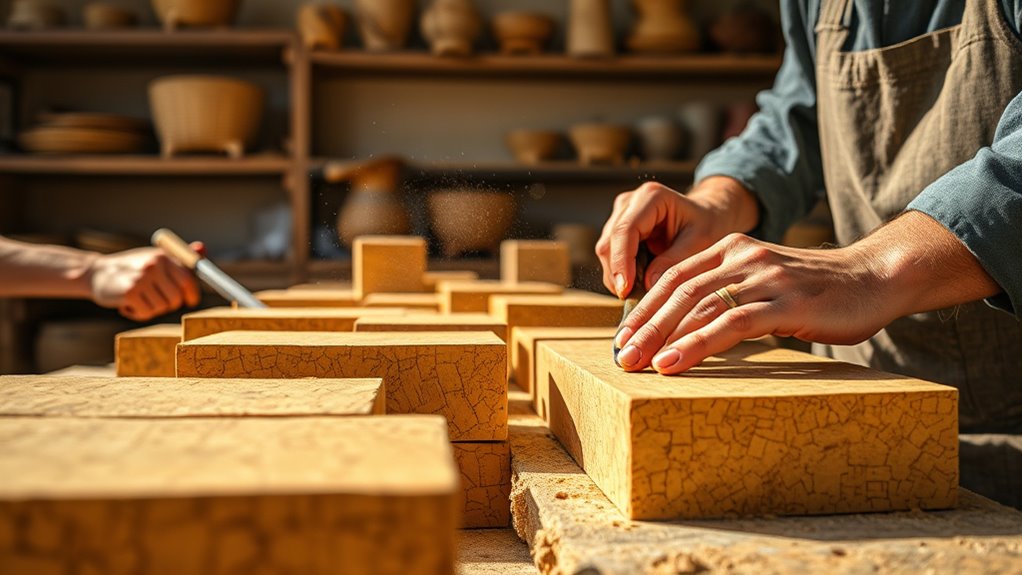
Preserving sustainability and heritage in Sardinian cork production relies on traditional practices that balance ecological health with cultural identity. You understand that cork oak trees must be at least 20 years old before first harvesting, with only outer bark removed during summer, allowing trees to recover over 9–12 years. This method ensures the trees, which can live up to a century, remain healthy and continue sequestering carbon. You also see how traditional processing—boiling, seasoning, and recycling cork waste—minimizes environmental impact. Cork oak trees dominate most of Sardinia’s landscape. Craftsmanship, rooted in centuries-old techniques passed down through generations, keeps Sardinian cultural identity alive. Local workshops, museums, and festivals celebrate cork’s history, while certifications and family-run businesses guarantee quality and sustainability. This harmonious blend of tradition and ecology sustains Sardinia’s cork heritage today and for future generations.
Frequently Asked Questions
How Does Cork Quality Vary Across Different Sardinian Regions?
You might notice cork quality varies across Sardinian regions due to environmental factors. In arid, low-altitude areas, cork tends to be thicker, denser, and higher quality, especially in eastern zones with granite soils. Conversely, cooler, humid, high-altitude places produce thinner, less dense cork. Regional management practices also influence quality, with better silviculture leading to improved cork characteristics. So, your cork’s quality depends on where and how it’s grown within Sardinia.
What Are the Environmental Impacts of Cork Harvesting on Forests?
Think of cork harvesting like trimming a healthy, resilient tree to keep it thriving. When you harvest cork sustainably, you actually boost the forest’s ability to absorb CO2, prevent soil erosion, and support biodiversity. By carefully stripping bark every 9–12 years, you allow the trees to live over a century, maintaining ecological balance. Your responsible practices help protect these forests’ health, ensuring they continue to provide essential environmental benefits.
How Do Traditional Cork Crafts Influence Sardinian Cultural Identity?
You see how traditional cork crafts shape Sardinian cultural identity by showcasing resilience and resourcefulness. These crafts preserve age-old techniques, blending them with modern creativity, which helps you connect to your heritage. They also foster community pride and engagement, making you feel part of a larger cultural story. By practicing and valuing these crafts, you help maintain Sardinia’s unique cultural traits and pass down its rich traditions to future generations.
What Innovations Are Emerging in Sardinian Cork Processing Technology?
Think of Sardinian cork processing as a symphony of tradition and innovation. You’re witnessing cutting-edge techniques like the REVO-BOIL system, which uses superheated water to purify cork more effectively. New methods boost quality, reduce environmental impact, and enhance traceability with certifications. By combining advanced technology with sustainable practices, you help preserve Sardinia’s cork legacy while ensuring top-tier products for global markets.
How Are Local Communities Involved in Cork Forest Conservation Efforts?
You play a crucial role in cork forest conservation by supporting sustainable harvesting practices and participating in community-led monitoring efforts. Your local knowledge helps preserve biodiversity and guarantees forest health. By engaging in traditional methods and promoting environmental awareness, you strengthen cultural ties and economic resilience. Your involvement fosters a shared sense of responsibility, guaranteeing that cork forests remain healthy, multifunctional landscapes that benefit both nature and your community.
Conclusion
As you explore Sardinia’s cork landscape, you see a blend of tradition and innovation shaping its future. While ancient harvesting methods honor centuries-old crafts, modern processing pushes boundaries with new uses and sustainability. It’s a delicate balance—preserving cultural heritage amid changing markets. In this island’s cork story, you find resilience in tradition and adaptability in growth, proving that respecting the past can drive a sustainable, vibrant future.


